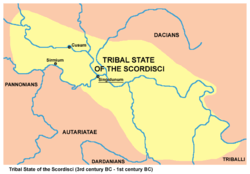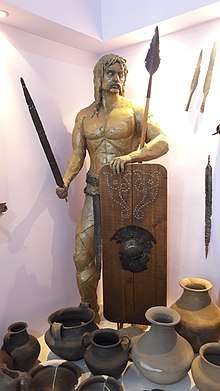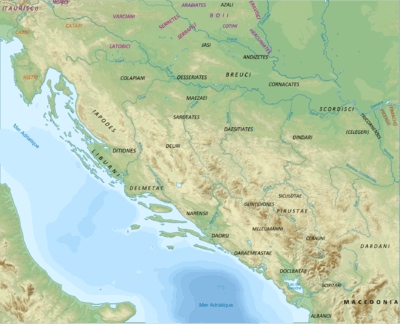Scordisci
The Scordisci (Greek: Σκορδίσκοι) were a Celtic Iron Age cultural group centered in the territory of present-day Serbia, at the confluence of the Savus (Sava), Dravus (Drava) and Danube rivers. They were historically notable from the beginning of the third century BC until the turn of the common era, and consolidated into a tribal state. At their zenith, their core territory stretched over regions comprising parts of present-day Serbia, Croatia, Bulgaria and Romania, while their influence spread even further. After the Roman conquest in the 1st century AD, their territories were included into the Roman provinces of Pannonia, Moesia and Dacia.
Scordisci | |||||||
|---|---|---|---|---|---|---|---|
| 278 BC–15 BC | |||||||
 Tribal state of the Scordisci (3rd–1st century BC) | |||||||
| Status | Independent tribal state | ||||||
| Capital | Singidunum (present-day Belgrade)[1] | ||||||
| Common languages | Paleo-Balkanic | ||||||
| Religion | Paleo-Balkan | ||||||
| Historical era | Antiquity | ||||||
• Established | 278 BC | ||||||
• Disestablished | 15 BC | ||||||
| |||||||
| Today part of | Serbia, Croatia, Bosnia and Herzegovina, Bulgaria and Romania | ||||||
Origin
The Scordisci were a Celtic group formed after the Gallic invasion of the Balkans,[2] or rather a "Celtic political creation"[3] having mixed with the local Thracians and Illyrians.[4] Their tribal name may be connected to the Scordus, the Šar mountain.[5] The personal names are noted to have been subsequently Illyricized, having South Pannonian–North Dalmatian influence.[6] According to onomastic evidence, Scordiscan settlements to the east of the Morava river were Thracianized.[7] In parts of Moesia (northeast Central Serbia) the Scordisci and Thracians lived beside each other, which is evident in the archeological findings of pits and treasures, spanning from the 3rd century BC to the 1st century BC.[8]
The Scordisci were found during different timelines in Illyria, Thrace and Dacia, sometimes splitting into more than one group like the Scordisci Major and the Scordisci Minor.[9]
Extensive La Tène type finds, of local production, are noted in Pannonia as well as northern Moesia Superior, attesting to the concentration of Celtic settlements and cultural contacts. However, such finds south of the Sava river are scarce.[10]
Domain

The Scordisci were centered in the territory of present-day Serbia, at the confluence of the Sava,[11] Drava[12] and Danube rivers. The Scordisci consolidated into a tribal state. At their zenith, their core territory stretched over regions comprising parts of present-day Serbia, Croatia, Bulgaria and Romania, while their influence spread even further.[13][14]
Culture
The Romans reported that they had the custom of drinking blood and that they sacrificed prisoners to deities equated with the Roman Bellona and Mars.[15]
History
4th and 3rd century BC
Celtic expansion reached the Carpathians in the beginning of the 4th century BC.[16] According to a Livy, perhaps based on Celtic legend, the Celts that migrated to Italy and Illyria numbered 300,000.[16] The Celts established themselves in Pannonia, subjugating the Pannonians, and in the end of the 4th century they renewed raids into the Balkans.[16] By the early 3rd century BC, Pannonia had been Celtiziced.[17] The Celts, retreating from Delphi (280–278 BC), settled on the mouth of the Sava and called themselves Scordisci.[17] The Scordisci established control to the north of the Dardani.[18] There is no mention of the Scordisci until the reign of Philip V of Macedon (r. 221–179 BC), when they emerge as Macedon allies against the Dardani and Rome.[18] The Scordisci, having conquered the important Sava valley, the only route to Italy, in the second half of the 3rd century BC, "gradually became the most important power in the northern Balkans".[19]
They controlled the various Pannonian groups in the region, extracting tribute and enjoying the status of the most powerful group in the central Balkans (see the Triballi, Autariatae, Dardanians and Moesians), and they erected fortresses in Singidunum[20] (today's city of Belgrade) and Taurunum (modern Zemun). They subjugated a number of groups in Moesia, including the Dardani, several west Thracian tribes and the Paeonians.
2nd century BC
The Scordisci most likely subdued the Dardani in the mid-2nd century BC, after which there are for long no mention of the Dardani.[21] From 141 BC, the Scordisci were constantly involved in battles against Roman held Macedonia. They were defeated in 135 BC.[22][23] by Cosconius in Thrace.[24] In 118 BC, according to a memorial[25] stone discovered near Thessalonica, Sextus Pompeius, probably the grandfather of the triumvir, was slain fighting against them near Stobi. In 114 BC, they surprised and destroyed the army of Gaius Porcius Cato[26] in the western mountains of Serbia, but two years later they were defeated by Marcus Livius Drusus (112 BC) and a few years later again by Minucius Rufus (107 BC).[27] Yet, they did not give up their claim over Pannonia, since they are mentioned as having battled in the second siege of Sisak in 119 BC.
1st century BC
They still, from time to time, gave trouble to the Roman governors of Macedonia, whose territory they invaded in combination with the Maedi and Dardani. They even advanced as far as Delphi and plundered the temple; but Lucius Cornelius Scipio Asiaticus finally overcame them in 88 BC and drove them across the Danube. After this, the power of the Scordisci declined rapidly. This decline was more a result of the political situation in barbaricum rather than the effects of Roman campaigns, as their clients, especially the Pannonians, became more powerful and politically independent. Between 56 and 50 BC, the Scordisci were defeated by Burebista's Dacians, and became subject to him.[28]

They were crushed in 15 BC by Tiberius,[29] and became Roman subjects, playing the part as mercenaries.[30] Other sources say the Romans made alliance with the Scordisci in Sirmium and Danube valleys following the Alpine campaign under Tiberius in 15 BC, the alliance would be crucial for the victory over the Pannonians (15BC) and later Breuci (12BC).
1st century AD
Strabo's Geographica (20 BC–23 AD) mentions that part of the Scordisci, the Major Scordisci, lived between the mouth of the Sava and mouth of the Morava,[31] while the other part, the Minor Scordisci, lived to the east of the Morava, bordering the Moesi and Triballi.
They started receiving Roman citizenship during Trajan's rule (98–117 AD).[32] With their Romanization, they ceased to exist as an independent ethno-political unit.[33]
Archaeological sites
- Singidunum (Belgrade Fortress and Karaburma)
- Taurunum (Zemun)
- Capedunum (Užice)
Legacy
The Scordisci are regarded the founders of Belgrade.
See also
| Wikimedia Commons has media related to Scordisci. |
References
- Harry Mountain (1998). The Celtic Encyclopedia. Universal-Publishers. pp. 215–. ISBN 978-1-58112-890-1.
- Wilkes 1992, p. 84 "Autariatae at the expense of the Triballi until, as Strabo remarks, they in their turn were overcome by the Celtic Scordisci ..."
- Mócsy 1974, p. 12 "the Scordisci ... are to be regarded merely one of the Celts' political creations and not as a Celtic tribe..."
- Dáithí Ó hÓgáin (2002). The Celts: A History. Boydell Press. p. 60. ISBN 978-0-85115-923-2.
... element among the more numerous local populations of Thracians and Illyrians. The most powerful such new group of mixed Celts was the Scordisci...
- James Cowles Prichard (1831) [1831]. The eastern origin of the Celtic nations proved by a comparison of their dialects with the Sanskrit, Greek, Latin and Teutonic languages. ISBN 0-543-79440-7.
The name Scordisci is from the mountain Scordus, and the Scordisci are Kelts.
- Mócsy 1974, p. 66 [referring to personal names]: "...the names of the Scordici are south Pannonian- north Dalmatian, ie they have been Illyricized."
- Mócsy 1974, p. ?
- "Archived copy" (PDF). Archived from the original (PDF) on 2011-07-18. Retrieved 2010-09-21.CS1 maint: archived copy as title (link)
- Ralph Haeussler; Anthony C. King; Phil Andrews (1 January 2007). Continuity and Innovation in Religion in the Roman West. Journal of Roman Archaeology. ISBN 978-1-887829-67-0.
... have constituted the population of the Scordisci, divided into the Scordisci Maior west of the Velika Morava river and the Scordisci Minor east of it...
- Mócsy 1974, p. 26 "Recent excavations have produced La Tène finds in the northern part of Moesia Superior, in the territory of the Scordisci, in the southern part of this province, where the Scordisci were only temporarily in control, the influence of La Tène culture is not attested."
- A History of Rome by Marcel Le Glay, Jean-Louis Voisin, Yann Le Bohec, and David Cherry, ISBN 1-4051-8327-6, 2009, page 101: "... 119-107 BCE Attacks on Macedonia's northern frontier by the Scordisci, a Thracian tribe who lived along the lower Save, were ..."
- Harry Thurston Peck, Harpers Dictionary of Classical Antiquities (1898), "Scordisci: A people in Pannonia Superior, are sometimes classed among the Illyrians, but were the remains of an ancient and powerful Celtic tribe. They dwelt between the Savus and Dravus."
- Todorović 1974, p. 268.
- John D. Grainger (1 January 2002). The Roman War of Antiochos the Great. BRILL. pp. 82–. ISBN 90-04-12840-9.
- Papazoglu 1978, pp. 507-508.
- Mócsy 1974, p. 5.
- Mócsy 1974, p. 7.
- Mócsy 1974, p. 9.
- Mócsy 1974, p. 10.
- Celts and the Classical World by David Rankin, ISBN 0-415-15090-6, 1996, p. 188: "...of the survivors of Brenus expedition the Scordisci founded Singidunum..."
- Mócsy 1974, p. 12.
- The praetorship in the Roman Republic by T. Corey Brennan, 2000, page 229, "For his part, Cosconius campaigned successfully against the Scordisci..."
- Papazoglu 1978, p. 286 "As to where the battle between the Scordisci and Cosconius' troops took place, nothing definite can be said. The Scordisci had perhaps entered Thrace [...]"
- Livy (8 November 2007). Rome's Mediterranean Empire: Books 41-45 and the Periochae. Oxford University Press. pp. 268–. ISBN 978-0-19-160539-0.
In Thrace, the praetor Marcus Cosconius fought successfully against the Scordisci [...]
- Marjeta Šašel Kos (2005). Appian and Illyricum. Narodni Muzej Slovenije. p. 151. ISBN 978-961-6169-36-3.
A general who lost his life during an attack by the Scordisci is even epigraphically attested: the praetor Sextus Pompeius. His defeat is documented [...]
- John Hazel (26 September 2002). Who's Who in the Roman World. Routledge. pp. 58–. ISBN 978-1-134-59251-7.
Cato 1, Gaius Porcius [...] was consul in 114 BC, when he lost a battle against the Scordisci in Macedonia [...]
- The Cambridge Ancient History Volume 9: The Last Age of the Roman Republic, 146-43 BC by J. A. Crook, Andrew Lintott, and Elizabeth Rawson, 1994, ISBN 0-521-25603-8, Back matter, "M.Minucius Rufius over the Scordisci and the Thracians..."
- Dacia: Land of Transylvania, Cornerstone of Ancient Eastern Europe by Ion Grumeza, ISBN 0-7618-4465-1, 2009, p. 51: "... Many Scordisci and Breuci settled in Dacia nevertheless and were eventually absorbed into the local population."
- Paterculus: The Tiberian Narrative (Cambridge Classical Texts and Commentaries) by Velleius Paterculus and A. J. Woodman, ISBN 0-521-60935-6, 2004, p. 106, "...that in 12 B.C. Tiberius used the Scordisci tribe as allies, though in 16 they had been enemies of Rome (54.20.3). V. has already told us (39-3) that it was he who reconciled these natives to Rome presumably around 15 after his Alpine campaigns..."
- Tiberius (Blackwell Ancient Lives) by Robin Seager, ISBN 1-4051-1529-7, 2005, p. 21, "Tiberius subdued Pannonia, making good use of a friendly tribe, the Scordisci."
- Vasa Čubrilović (1974). Istorija Beograda. 1. p. 41.
Страбон ... Велики Скордисци
- Wilkes 1992, p. 256 "... reign of Trajan (AD 98-117), does the Roman citizenship begin to appear among the Illyrian communities of southeast Pannonia, the Andizetes, Scordisci and Breuci."
- Wilkes 1992, p. 145 "Autariatae had vanished long before the Roman conquest, and the Triballi, Scordisci and Moesi all declined to insignificant remnants, the Dardani endured."
Sources
- Gavela, Branko (1951). Skordisci u našoj zemlji prema antičkim piscima (in Serbian). OCLC 25853423.
- Mócsy, András (2014) [1974]. Pannonia and Upper Moesia: A History of the Middle Danube Provinces of the Roman Empire. New York: Routledge.
- Papazoglu, Fanula (1978). The Central Balkan Tribes in pre-Roman Times: Triballi, Autariatae, Dardanians, Scordisci and Moesians. Amsterdam: Hakkert.CS1 maint: ref=harv (link)
- Popović, Petar (1987). Новац Скордиска: новац и новчани промет на централном Балкану од IV до I века пре н. е (in Serbian). Археолошки институт. OCLC 681917288.
- Todorović, Jovan (1974). Skordisci: istorija i kultura (in Serbian). Institut za izučavanje istorije Vojvodine.CS1 maint: ref=harv (link)
- Wilkes, John J. (1992). The Illyrians. ISBN 0-631-19807-5.CS1 maint: ref=harv (link)
- Živković, Tibor (2000). Sloveni i Romeji (in Serbian). Istorijski Institut SANU. OCLC 249776821.